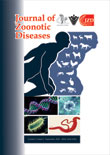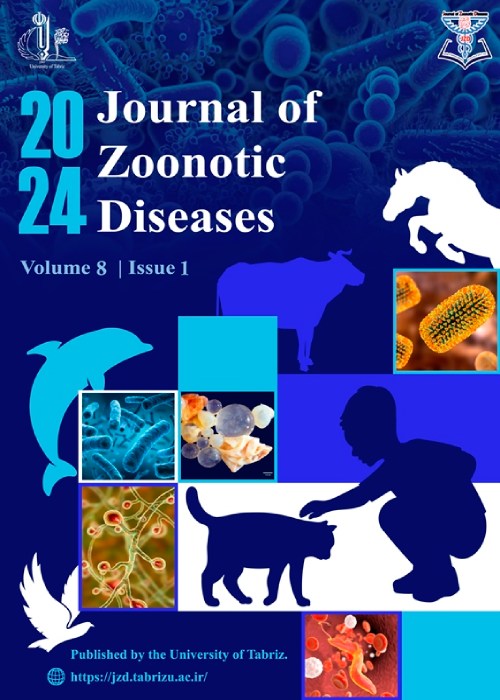فهرست مطالب

Journal of Zoonotic Diseases
Volume:2 Issue: 2, Autumn 2017
- تاریخ انتشار: 1396/08/25
- تعداد عناوین: 7
-
-
Page 1Letter from Editor-in-Chief
It is a great pleasure to inform all scientists, physicians, veterinarians, epidemiologists, researchers in bio medical areas and other researchers who work for "One World, One Health" all around the world.
I am delighted to take on the role of Editor-in-Chief of "Journal of Zoonotic Diseases" (JZD) and would like to take this opportunity to introduce JZD. JZD is a unique source for veterinary medicine. It has a distinguished Editorial Board, including key opinion leaders with international reputations. It also publishes high quality articles written by experts in several branches of human and veterinary medicines. JZD's open access format allows the articles to be readily available at the time of publication to the research community and the public.
We also hope to continue to evolve and have good idea on how to proceed. In guiding the editorial team in the choices, we have to make, we ask our readers to help us to explore new ways to make the journal useful: please share your ideas and thoughts with us. We look forward to hearing from you soon.
I strongly encourage you to submit your work for consideration for publication in JZD. An enthusiastic submission requires an energetic and dedicated editorial board to ensure that your article will be reviewed and published rapidly. To reach this goal, we have tested many solutions and have adopted a simple Online Submission System for Authors and Reviewers. Starting immediately, all manuscripts and editorial communications should be sent via our Online Submission System by logging on to "http://www.jzd.tabrizu.ac.ir". -
Pages 2-16Mycobacterium bovis (M. bovis) infection in humans is not adequately diagnosed since classical biochemical and cultural tests are both sophisticated and time consuming. However, being intrinsically resistant to Pyrazinamide, the species-specific identification of M. bovis is clinically significant. The present study was performed to determine the prevalence of Zoonotic M. bovis-induced tuberculosis (TB) in the malnourished tribal population of Melghat using a duplex PCR assay targeting the regions of difference (RD) 1 and 4. A prospective cohort study was carried over a period of 2 years from 2011 to 2013 in the Melghat region of Maharashtra, India. A total number of 347 blood samples were collected from participants recruited through camps organized in 10 different villages of Melghat. The samples were then subjected to duplex PCR assay for differential identification of the mycobacterial pathogens viz., M. tuberculosis (M. tb), M. bovis and M. bovis BCG. The duplex PCR assay identified M. bovis in 2.59% (9/347) and M. tb in 17.29% (60/347) of samples. Altogether the 9 M. bovis positive cases had exposure to domesticated animals or consumed raw, unpasteurized milk. This study provided a rapid and cost effective molecular tool for screening of M. bovis in the isolated regions of Melghat.Keywords: Duplex PCR, Mycobacterium bovis, Tuberculosis, Zoonotic TB
-
Pages 17-26is strong evidence that the use of antimicrobials can lead to the appearance and rise of bacterial resistance both in human and animals. Escherichia coli (E. coli) isolates from human and chicken samples were examined for their biofilm formation ability and antibiotic resistance patterns in this study. A total of 100 E. coli samples, isolated from humans and chickens were examined to determine the biofilm forming properties by tube test, cover slip test and microtitre plate method. After which the prevalence of antimicrobial resistance among the organisms was determined. Among avian isolates, tissue culture plate method, cover slip test and tube assay detected 68%, 54% and 60% antimicrobial resistance, respectively. In human isolates 72%, 56% and 66% antimicrobial resistance were evidence by tissue culture plate method, cover slip test and tube assay, respectively. The resistance pattern of these isolates showed that E. coli from chicken samples was resistant to Nalidixic acid (100%), Ciprofloxacin (80%), Doxycycline (80%), Tetracycline (76%), Cefotaxime (30%), Ceftriaxone (30%), Amikacin (28%), Nitrofurantoin (24%), Ceftazidime (22%), Furazolidone (20%), Cefixime (10%), and Gentamicin (0%). E. coli from human clinical samples was resistant to Tetracycline (62%), Doxycyclie (58%), Ciprofloxacin (58%), Nalidixic acid (50%), Ceftazidime (40%), Cefotaxime (36%), Ceftriaxon (24%), Cefixime (20%), Amikacin (16%) and gentamicin (8%), Furazolidone (4%) and Nitrofurantoin (0%). Furthermore multi resistant E. coli isolates were common in human and chicken samples. However, the percentages of multi resistant E. coli were higher in chicken than in human isolates. The results of this study suggested that chickens can act as reservoirs for transfer of antimicrobial resistant bacteria to humans. Furthermore, all of the E. coli biofilm producers from human and avian origins had multidrug resistance patterns and biofilm formation ability can increase the antibiotic resistance profile of E. coli isolates.Keywords: E. coli, biofilm, Antimicrobial resistance
-
Pages 27-36Brucellosis is a zoonotic disease affecting the wellbeing of human and animals mainly in developing countries. Small ruminants are highly adaptable to broad range of environmental conditions and are the most important income sources for poor households. A cross sectional study was carried out on a total of 283 animals (99 sheep and 184 goats) from October 2016 till April 2017 to estimate seroprevalence of small ruminant brucellosis. In addition, a structured questionnaire was filled out by 126 respondents of 10 peasant associations (PAs) to assess community awareness about zoonotic importance of diseases. The overall seroprevalence of the brucellosis in small ruminant was 23 (8.1%) (95% CI: 5.2, 11.9) revealed by c-ELISA. The individual species seroprevalence of brucellosis was 9.2 (95%CI: 5.5, 14.4) and 6.1(95%CI: 2.3, 12.7) in goat and sheep, respectively. Among 126 respondents, 112 (88.9) of had no knowledge about zoonotic importance of brucellosis and its transmission routs, whereas 14 (11.1%) of them were aware of the disease. Consequently, the majority of the respondents handled all aborted fetus; assisted their animals during the parturition by bare hand without any protective clothing, consumed raw milk and animal blood. In addition, the physicians were not aware of the disease and they did not consider the brucellosis while treating patient submitted to health post with suggestive clinical sign of brucellosis. Therefore, integrated human and veterinary doctors disease control strategy should be developed and applied to control the disease both in human and animals.Keywords: Borena, Brucellosis, Pastoralist, Public awareness, Small ruminant
-
Pages 37-44The development of many biological assays relies on the usage of various laboratory animals. Extensive utilization of these animals in biomedical researches necessitated high quality hygienic and breeding conditions in animal houses. Moreover, many zoonotic diseases including parasitic, bacterial and viral infections are transferred from the laboratory animals to humans. This study investigated the prevalence of parasitic infections of some laboratory animals that were conventionally maintained in animal houses of research centers in Tabriz universities. Blood, fecal and cutaneous samples were collected from 70 laboratory animals (35 mice and 35 rats).The fecal samples were stained with Trichrome, Modified Zeil-Nelson Staining and observed by direct method. All blood samples (100%) were negative. Fecal examinations revealed the cyst of Giardia muris (57%), eggs of Ascaris (spp.) (17%), Oxyuris muris (93%), Syphacia muris (4%), Aspicularis tetraptera (2%), and Hymenolepis nana (9%). In cutaneous examinations Polyplax serrata (21%) and lice nit (55%) were observed. The present study indicated that the examined laboratory animals were infected with different enteric and cutaneous parasites. Thus, we suggest that the staff and researchers working in this area need to be aware of the risk of these infections. Moreover, the monitoring of animal houses is indispensable.Keywords: Parasitic infections, Laboratory animals, Research centers
-
Pages 45-50Linguatula serrata is an important zoonotic parasite at a global scale. The epidemiological role of sheep in transmission of linguatulosis has recently been demonstrated, but there is still a lack of information on the subject. The aim of the present study was to evaluate the occurrence and seroprevalence of L. serrata infection among sheep in Fars province, south of Iran, from December 2014 to September 2015. Blood samples were collected from 180 sheep in Shiraz abattoir. The antibody detection against L. serrata was made by counter immunoelectrophoresis (CIEP). Specific antibodies against L. serrata were detected in 84 (46.66%) out of 180 ovine sera. Out of 38 males, 21 under 1 year old (55.26 %) and out of 81 males, 36 older than 1 year (44.44%) were infected with nymphs. Fifteen out of 30 females under 1 year old (50%) and 12 out of 31 females above 1 year old (38.7%) were infected with nymphs. The age and the sex of infected sheep showed no significant differences between positive and negative cases (P≤0.05). The results of this study showed the presence of L. serrate among sheep in Iran, which could be a public health concern. According to the relatively high prevalence of L. serrata infection in sheep, implementation of control measures to reduce infection in both definitive and intermediate hosts are needed.Keywords: Fars, Linguatula serrata, Sheep, seroprevalence, counter immune electrophoresis (CIE)
-
Pages 51-56Myiasis is the infestation of tissues of animals or man by parasitic dipterous fly larvae. Enteric myiasis occurs when eggs or larvae of the fly, placed on food or water, then, swallowed by man and are passed out in faeces. This case report describes a type of intestinal myiasis caused by Sarcophaga species larva in a 34-year-old stable worker man in Kurdistan Province, western Iran. The clinical signs consisted of abdominal distress, gastroenteritis, abdominal pain and loose faces. Following the disposal of maggots in his stool, larvae were identified to be Sarcophaga spp. based on characteristic patterns of posterior spiracles. The symptoms were completely resolved within 2 days. The patient seems to have been infested accidentally. This paper is the second report of human enteric myiasis caused by Sarcophaga species.Keywords: Enteric myiasis, Sarcophaga spp, Iran


